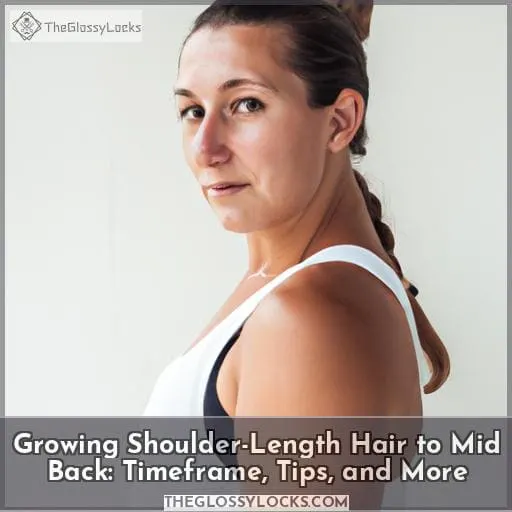This site is supported by our readers. We may earn a commission, at no cost to you, if you purchase through links.
 Imagine flowing, luscious locks cascading down your back, exuding confidence and beauty.
Imagine flowing, luscious locks cascading down your back, exuding confidence and beauty.
If you’re longing to grow shoulder-length hair to mid-back length, we’ve got you covered with all the tips and information you need. Discover how long it takes for hair to reach this desired length based on various factors such as genetics and hair care practices.
From nourishing your tresses properly to promoting healthy growth, our expert advice will guide you towards achieving the mane of your dreams.
Table Of Contents
- Key Takeaways
- How Long Does It Take to Grow Shoulder-Length Hair to Mid Back?
- Tips for Promoting Hair Growth and Retaining Length
- Common Hair Lengths and Their Timeframes
- Understanding Hair Growth Rates and Phases
- Hair Length Bias and Definitions
- Frequently Asked Questions (FAQs)
- What is the difference between shoulder-length hair and mid-back hair?
- How long does it take to grow shoulder-length hair to mid-back?
- What are the tips for promoting hair growth and retaining length?
- What are the common hair lengths and their timeframes?
- What is hair length bias and how does it affect hair growth?
- Conclusion
Key Takeaways
- The average human hair grows around 6 inches per year.
- Shoulder-length hair is around 12 inches, while mid-back hair is around 18 inches.
- Growing shoulder-length hair to mid-back takes at least a year, but for some people it could take two years or more.
- Factors affecting hair growth rate include genetics, diet, hormones, and overall hair care practices.
How Long Does It Take to Grow Shoulder-Length Hair to Mid Back?
Growing shoulder-length hair to mid-back length requires time and patience.
The average human hair grows around 6 inches per year, so it can take at least a year for your hair to grow from shoulder length (around 12 inches) to mid back (around 18 inches).
However, keep in mind that individual factors such as genetics, environment, hormones, and overall hair care practices can influence the speed of growth and terminal length.
Factors Affecting Hair Growth Rate
To determine how long it takes to grow shoulder-length hair to mid back, factors such as genetics and lifestyle choices play a significant role in the rate of hair growth.
Age, hormones, diet, medications, and hair care practices all contribute to the speed at which your hair grows.
Taking proper care of your hair by following a healthy diet and using appropriate products can help promote faster and healthier growth.
Additionally, incorporating vitamins or supplements targeted for optimal hair health may also support faster growth.
Terminal Length and Genetics
You can expect your shoulder-length hair to take at least a year, and possibly up to two years or more, to grow into mid-back length.
Terminal length is the maximum length that hair can grow, determined by genetics.
To promote healthy hair growth and prevent damage, focus on proper hair care practices such as regular trims and scalp care.
Additionally, maintaining a nutritious diet can support optimal hair health.
Tips for Promoting Hair Growth and Retaining Length
To promote hair growth and retain length, it’s important to practice proper hair care.
This includes:
- Using the right hair-washing method
- Protecting your hair from heat and sun damage
- Avoiding mineral and chlorine damage
- Brushing your hair gently
- Trimming regularly to prevent split ends
- Using nourishing treatments like masks or oils.
Additionally, maintaining a healthy scalp through regular massages and consuming a balanced diet rich in vitamins, minerals, fiber, and protein can contribute to optimal hair health.
Proper Hair Care Practices
Continue taking care of your hair by implementing proper hair care practices that promote growth and help retain length.
- Use silk pillowcases to reduce friction and prevent breakage while you sleep.
- Avoid heat styling tools, as they can damage the hair shaft.
- Regularly trim split ends to prevent them from traveling up the strand and causing further damage.
- Incorporate deep conditioning treatments like hair masks to nourish and hydrate your strands.
- Massage your scalp regularly to stimulate blood circulation, promoting healthy hair growth.
Nutritional Factors for Hair Health
One key factor in promoting hair growth and retaining length is ensuring you have a balanced diet that includes protein, iron, biotin, zinc, and vitamin C.
Eating foods high in these nutrients or taking supplements can provide the vitamins and minerals your hair needs to grow quickly from shoulder to mid back length.
Getting enough protein gives hair the building blocks it needs, while iron carries oxygen to follicles for growth. Biotin, zinc and vitamin C also support scalp health and stimulate faster, stronger hair growth.
Scalp Health and Blood Circulation
To promote hair growth and retain length, it’s important to maintain a healthy scalp and ensure proper blood circulation.
Here are some tips for improving scalp health:
- Regularly massage your scalp to stimulate blood flow.
- Use natural oils, such as coconut or jojoba oil, to nourish the scalp.
- Avoid using harsh chemicals or heat styling tools that can damage the hair follicles.
By taking care of your scalp, you can improve hair growth, density, thickness and shine.
Common Hair Lengths and Their Timeframes
When it comes to growing your shoulder-length hair to mid back, there are common hair lengths and their corresponding timeframes that you should be aware of.
These include:
- Bra strap length, which takes around 20 months to grow from chin length;
- Mid back length, which is about 6 months longer than bra strap length;
- Waist length, a rare but stunning option that turns heads.
If you’re aiming for even longer hair lengths like hip or calf-length, it’s important to understand the patience required as well as factors such as genetics and lifestyle changes that can influence growth.
Bra Strap Length
From promoting hair growth, let’s move on to discussing some common hair lengths and how long they take to reach.
Bra strap length hair sits below your armpits and takes about 20 months to grow from chin length.
With good hair care practices and nourishment, hair with natural curl and body waves can reach bra strap length from shoulder-length in around 24 months before continuing to waist length in another 12 months.
Though hair growth depends on genetics and intake of vitamins, bra strap length is achievable for most with some care and patience.
Mid Back Length
You’re often aiming for mid back length after hitting bra strap length, as it typically takes about 6 more months of growth from there.
This classic length is around 18 inches and rests between your shoulder blades, making it ideal for free-flowing styles or braids.
Focus on scalp health, nutrition, protective styling, and regular trims to retain those extra inches.
Many find mid back length strikes the perfect balance of length, fullness, and manageability for their hair goals.
Waist Length
After reachin’ mid back length, you’ll be gunnin’ for waist-length hair in about 8 more months of growth.
Waist-length hair is a stunning and rare hairstyle that turns heads wherever you go.
The pros of having waist-length hair include its versatility for various hairstyles and the wow factor it brings.
However, maintaining and styling waist-length hair can require extra time and effort compared to shorter lengths.
But don’t worry, with proper care and patience, achieving this beautiful length is definitely worth it!
Even Longer Hair Lengths
To achieve even longer hair lengths beyond waist length, such as hip to ankle, it requires dedicated patience and consistent hair care practices.
It’s important to prioritize proper hair care routines and nourish your strands with a balanced diet.
Set realistic length goals and be patient with the growth process. Remember that everyone’s hair grows at different rates, so don’t compare yourself to others.
Avoid excessive heat styling or chemical treatments that can cause damage and potential hair loss in the long run.
Understanding Hair Growth Rates and Phases
Understanding hair growth rates and phases is crucial when it comes to growing your shoulder-length hair to mid-back.
The anagen phase, which is the active growth phase of hair, can last between two and six years for most people.
Factors such as genetics, diet, hormonal changes, and environmental factors can influence the speed at which your hair grows.
Additionally, false terminal length caused by damaging haircare practices or previous cuts may hinder your progress.
By understanding these factors and taking care of your hair properly, you can work towards achieving longer lengths with patience and dedication.
Anagen Phase and Hair Growth Speed
During the anagen phase, your hair follicles are actively producing new hair strands at a specific growth speed.
The average human hair growth rate is around 6 inches per year. However, individual factors such as genetics and hormonal changes can influence this rate.
It’s important to note that everyone has a maximum terminal length for their hair, which can vary from person to person.
By understanding the anagen phase and promoting healthy hair care practices, you can optimize your natural growth potential and achieve longer lengths over time.
Factors Influencing Hair Growth Rate
Factors like genetics, diet, and hormonal changes can influence the rate at which your hair grows.
Here are three key influencers of hair growth rate:
- Genetics: Your genetic makeup plays a significant role in determining your hair’s thickness, density, and texture.
- Hormones: Fluctuations in hormone levels can affect the speed at which your hair grows.
- Age: As you age, the natural process of aging can slow down your hair’s growth rate.
By understanding these factors and taking steps to support optimal health and nutrition, you can encourage faster and healthier hair growth.
False Terminal Length
False terminal length is when your hair appears to have stopped growing, even though it hasn’t.
- Damaging haircare practices
- Resting periods in the hair’s growth
- Previous haircuts
With patience and proper hair care, you can eventually reach your desired hair length.
Hair Length Bias and Definitions
Understanding hair length bias and definitions is crucial when discussing the journey of growing shoulder-length hair to mid-back.
It’s important to remember that perceptions of hair length can vary from person to person, so it’s always a good idea to ask for clarification if needed.
In general, short hair refers to anything shorter than chin length, medium length falls between the shoulder and chin, and long hair encompasses everything below the shoulders.
By familiarizing yourself with these terms and understanding different perspectives on what constitutes as long or short hair, you’ll be better equipped on your own personal growth journey.
Short, Medium, and Long Hair
Short hair is shorter than chin length.
Medium length is between shoulder and chin.
Long hair is everything below the shoulder.
Keep in mind that hair length is a personal preference and there’s no right or wrong way to wear your hair.
Hair Length Terminology
Hair length can be a subjective topic, with what’s considered short, medium, or long depending on who’s speaking.
Your hair goals should be based on your own wants and needs, not on what others think.
Perceptions of Hair Length
What is considered long hair to you?
There’s no one-size-fits-all answer, as beauty standards vary depending on culture, personal preference, and individuality.
What matters most is that you love your hair and feel confident in it.
Frequently Asked Questions (FAQs)
What is the difference between shoulder-length hair and mid-back hair?
Shoulder-length hair is around 12 inches, while mid-back hair is around 18 inches.
Mid-back hair is a great length for braids and flowing hair.
How long does it take to grow shoulder-length hair to mid-back?
Growing shoulder-length hair to mid-back takes at least a year, but for some people it could take 2 years or more.
What are the tips for promoting hair growth and retaining length?
To promote hair growth and retain length, use the right hair-washing method, heat protectant sprays, and avoid sun damage.
Trim your hair every 3-4 months and avoid haircuts and hairstyling.
What are the common hair lengths and their timeframes?
Hair lengths are like a rainbow, with different lengths to suit everyone.
Bra strap length sits below the armpit.
Mid back length is great for braids and flowing hair.
Waist length turns heads.
What is hair length bias and how does it affect hair growth?
Hair length bias is a social construct that can affect hair growth. It can lead to people feeling pressure to conform to certain hair lengths, which can make it difficult to grow your hair long.
Conclusion
Picture yourself with long, flowing hair cascading down your back. With proper care and patience, you can achieve this dream! Growing shoulder-length hair to mid-back length takes an average of two to three years, but there are ways to speed up the process.








